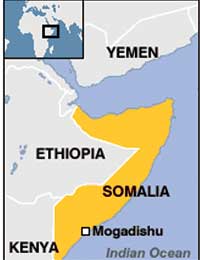|
issue
of the week There is not a country where superpower involvement is absent. That is obviously one of the traits of a superpower. Even in countries like Iran with whom the United States has no diplomatic relations, the superpower gets involved through proxies or groups opposed to the regime. But in countries where the United States plays a larger-than-life role, either by diplomatic or military means, the United States keeps on doing the same mistake. It backs the wrong horse in a conflict.
When the people of Iran were rallying behind Ayatollah
Rohollah Khomeini during the Islamic Revolution in the late 1970s,
the United States tried its best to protect the unpopular Shah.
Before that in Vietnam, too, it was trying to protect the US-installed
puppet regime which the majority of the Vietnamese did not recognize.
The result of siding with the unpopular regime and earning the wrath
of the masses was un-ceremonial withdrawal from these countries. In recent weeks, events in Somalia show that the United States backed the wrong horse in the bloody power struggle that had left this African nation without a proper government for nearly 15 years. It supported various war lords while ignoring the people's desire to rally behind a force that was capable of uniting its various feuding factions. Some six months ago, CNN showed a special feature on Somalia. The underlying theme of the programme was the United States war on terror. The programme was presented with the reporter accompanied by a US military officer taking a ride on a US military plane. The plane was flying low over Somali airspace and the military officer was showing the areas where different warlords were in control. This was at a time when nobody knew who was governing Somalia. The military officer boasted of keeping Somalia under surveillance and claimed that the situation was under control-meaning everything was going well for the United States in Somalia, a country from which it beat a hasty retreat in the early 1990s after the American people saw a barbaric scene of Somali gunmen dragging the body of a pilot of a downed US aircraft. Smarting over the humiliation, some hawks in the Bush administration felt that the United States had a score to settle with in Somalia. In the wake of the 9/11 attack on the United States, there were moves to bring Somalia also into the larger picture of terrorism. Many believed that Somalia would be targeted after Afghanistan. But fortunately, Somalia did not have a government and the United States did not have an enemy in person -- like Osama bin Laden or Saddam Hussein - in Somalia. A Wall Street Journal report on December 12, 2001 quoted a US intelligence review as concluding that there was a small al-Qaeda presence in Somalia that could be "rooted out with limited operation by US forces or allies". A Somali Islamic group called Al Itthihad al Islamiya was placed on the US list of terrorist organizations and accused of having links with al-Qaeda. It was believed then that al-Qaeda and Taleban fighters fleeing Afghanistan in the face of unrelenting US bombardment would sneak into Somalia. An interdiction force of 30 to 40 US naval ships, submarines and P-3 aircraft backed by Australian, Italian, British and Canadian craft patrolled the sea and airspace of Somalia with the help of the neigbouring Ethiopia to prevent al-Qaeda members from seeking refuge in the war-torn African country. However, the so-called coalition forces found no
evidence to prove that al-Qaeda had links with Somali factions or
it operated a cell in Somalia. The United State's intervention in Somalia dates
back to the Cold War days. Somalia turned to the United States when
the Soviet Union abandoned it and backed Ethiopia during the 1964
war between the two African nations. The shooting down of the US aircraft by Aidid's men prompted President Bill Clinton to withdraw US troops. He probably did not want to get embroiled in a Vietnam or Lebanon-like situation. From then onwards, Somalia did not have a proper government. Different warlords ruled different parts of the country. It was only in 2000 that Somali factions met in Djibouti to establish a national charter or an interim constitution and appoint a president. Abdikassam Salad Hassan, an aide of Said Barre, was elected president but a number or warlords refused to recognize the new government. Another government-making effort was undertaken in 2002 with neighbouring Kenya facilitating. But fighting continued till 2004 when a Somali parliament was convened in Kenya and Abdullah Yusuf Ahmed was elected President. But the problem with Somalia was it had different governments. It was against this backdrop that the people started to rally behind the Islamists, known as Islamic courts. The Union of Islamic Courts which defeated warlord after warlord in its march towards the capital, Mogadishu, is not like the Taleban. This would have probably disappointed those who are prosecuting the war on terror and those who are promoting Islamophobia in the West. Leaders of the Somali Islamic Court which now controls much of Somalia have said that their task was not to impose Shariah law on the people and assured that Somalia would not be a haven for extremists. On Friday, the Islamic Court and the interim government of Abdullah Yusuf Ahmed signed a peace deal in Sudan agreeing to recognize each other and stop fighting. Meanwhile, another factor that was uniting the Somalis is their common hatred of Ethiopia which the Somali people accuse of occupying what they regard as Somali territory and of interfering in Somali's internal affairs. There is allegation that President Ahmed is a stooge of Ethiopia. It appears that after 15 years of mayhem and anarchy, Somalia is close to forming a national government. The task of the international community is to support Somalia's new nation-building effort rather than pandering to the wishes of rightwing hawks. |
||||
Copyright © 2006 Wijeya Newspapers
Ltd. All rights reserved. |

